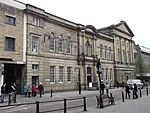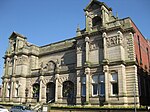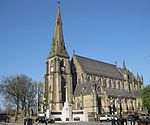
Bury is a market town on the River Irwell in the Metropolitan Borough of Bury, Greater Manchester, England. which had a population of 81,101 in 2021 while the wider borough had a population of 193,846.

The 29th Division, known as the Incomparable Division, was an infantry division of the British Army, formed in early 1915 by combining various Regular Army units that had been acting as garrisons around the British Empire. Under the command of Major-General Aylmer Hunter-Weston, the division fought throughout the Gallipoli Campaign, including the original landing at Cape Helles. From 1916 to the end of the war the division fought on the Western Front in Belgium and France.

The 42nd Infantry Division was an infantry division of the British Army. The division was raised in 1908 as part of the Territorial Force (TF), originally as the East Lancashire Division, and was redesignated as the 42nd Division on 25 May 1915. It was the first TF division to be sent overseas during the First World War. The division fought at Gallipoli, in the Sinai desert and on the Western Front in France and Belgium. Disbanded after the war, it was reformed in the Territorial Army (TA), in the Second World War it served as the 42nd Infantry Division with the British Expeditionary Force (BEF) and fought in Belgium and France before being evacuated at Dunkirk. The division was later reformed in the United Kingdom and, in November 1941, was converted into the 42nd Armoured Division, which was disbanded in October 1943 without serving overseas. A 2nd Line duplicate formation, the 66th Infantry Division, was created when the Territorials were doubled in both world wars.

The Fusiliers Museum of Northumberland, formerly the Northumberland Fusiliers Museum, is a museum located within the Abbot's Tower of Alnwick Castle in Alnwick, Northumberland, England.
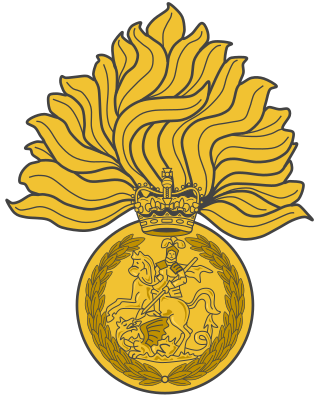
The Royal Regiment of Fusiliers is an infantry regiment of the British Army, part of the Queen's Division. Currently, the regiment has two battalions: the 1st Battalion, part of the Regular Army, is an armoured infantry battalion based in Tidworth, Wiltshire, and the 5th Battalion, part of the Army Reserve, recruits in the traditional fusilier recruiting areas across England. The Royal Regiment of Fusiliers was largely unaffected by the infantry reforms that were announced in December 2004, but under the Army 2020 reduction in the size of the Army, the 2nd Battalion was merged into the first in 2014.

The Lancashire Fusiliers was a line infantry regiment of the British Army that saw distinguished service through many years and wars, including the Second Boer War, the First and Second World Wars, and had many different titles throughout its 280 years of existence. In 1968 the regiment was amalgamated with the other regiments of the Fusilier Brigade – the Royal Northumberland Fusiliers, Royal Warwickshire Fusiliers and the Royal Fusiliers – to form the current Royal Regiment of Fusiliers.
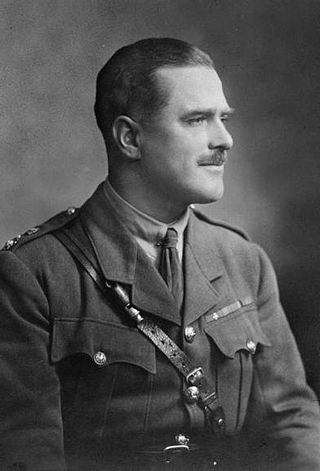
Major Richard Raymond Willis VC was an English recipient of the Victoria Cross, the highest and most prestigious award for gallantry in the face of the enemy that can be awarded to British and Commonwealth forces.

Frank Edward Stubbs was an English recipient of the Victoria Cross, the highest and most prestigious award for gallantry in the face of the enemy that can be awarded to British and Commonwealth forces.

Lance Sergeant William Stephen Kenealy VC, was an Irish recipient of the Victoria Cross, the highest and most prestigious award for gallantry in the face of the enemy that can be awarded to British and Commonwealth forces.
Sergeant Alfred Joseph Richards VC was an English recipient of the Victoria Cross, the highest and most prestigious award for gallantry in the face of the enemy that can be awarded to British and Commonwealth forces.

The Royal Inniskilling Fusiliers was an Irish line infantry regiment of the British Army in existence from 1881 until 1968. The regiment was formed in 1881 by the amalgamation of the 27th (Inniskilling) Regiment of Foot and the 108th Regiment of Foot.

Brooke is a village and civil parish in the South Norfolk district of Norfolk, England, about 7 miles south of Norwich and roughly equidistant from Norwich and Bungay.

Captain Harold Thomas Cawley was a British barrister, Liberal Party politician and soldier.

The Royal Regiment of Fusiliers Museum (Royal Warwickshire) is situated at Pageant House in Jury Street, Warwick, England.

This is an order of battle listing the Allied and Ottoman forces involved in the Gallipoli campaign during 1915.

Wellington Barracks was a military installation on Bolton Road in Bury, Greater Manchester.
The 1915 Birthday Honours were appointments by King George V to various orders and honours to reward and highlight good works by citizens of the British Empire. The appointments were made to celebrate the official birthday of The King, and were published in The London Gazette and in The Times on 3 June 1915.

The Lancashire Fusiliers War Memorial is a First World War memorial dedicated to members of the Lancashire Fusiliers killed in that conflict. Outside the Fusilier Museum in Bury, Greater Manchester, in North West England, it was unveiled in 1922—on the seventh anniversary of the landing at Cape Helles, part of the Gallipoli Campaign in which the regiment suffered particularly heavy casualties. The memorial was designed by Sir Edwin Lutyens. Lutyens was commissioned in light of a family connection—his father and great uncle were officers in the Lancashire Fusiliers, a fact noted on a plaque nearby. He designed a tall, slender obelisk in Portland stone. The regiment's cap badge is carved near the top on the front and rear, surrounded by a laurel wreath. Further down are inscriptions containing the regiment's motto and a dedication. Two painted stone flags hang from the sides.

The Castle Armoury is a military installation in Bury, Greater Manchester, England.
The 1st Manchester Rifles, later the 6th Battalion, Manchester Regiment, was a unit of Britain's Volunteer Force and Territorial Army recruited in and around Manchester. It served as infantry at Gallipoli, fighting with distinction at the Third Battle of Krithia, and in some of the bitterest battles on the Western Front in the First World War. After conversion into an anti-aircraft unit of the Royal Artillery between the wars, it defended Manchester, Scapa Flow and Ceylon during the Second World War and continued in the air defence role until 1955.























